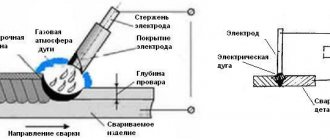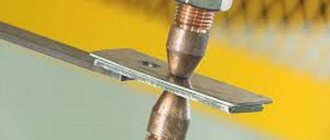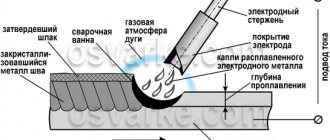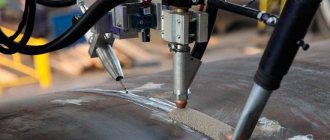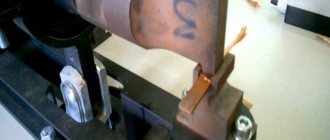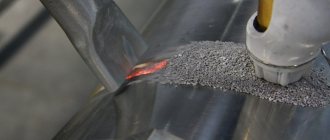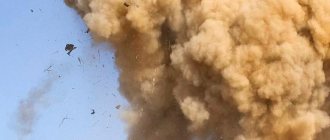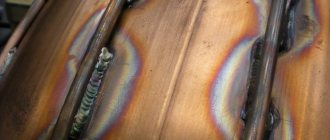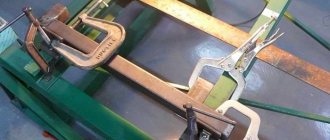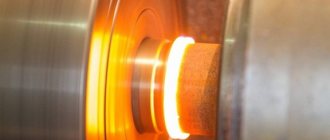Bath welding of reinforcement is the most reliable method of connecting individual sections of metal structures made of high-strength alloy steel. The welding result is influenced by a number of factors, one of which is the alignment of the joined sections.
When carrying out conventional butt welding, the quality of the seam will be unreliable, the connection will break near the seam. Therefore, a solution has been developed for a more durable connection of the longitudinal and transverse sections of the reinforcing mesh - the pool welding method. Under significant loads during operation, the structure has sufficient rigidity, and the welding seam on the connection is small.
State standards
For this construction process, a GOST was developed called “Joints of welded reinforcement and embedded products of reinforced concrete structures.” The standard was introduced on July 1, 1992 under the number 14098-91.
Bath welding is a reliable and commonly used method. A distinctive feature of this process from all other types of welding is its continuity, which is very important for uniform melting. Thanks to this process, the metal melts much faster.
The welding method is used in the construction of various massive structures and buildings. The seam created using this welding is capable of withstanding moving loads without destroying the integrity of the structure and meets the requirements of GOST. If conventional butt welding is carried out, it can lead to failure of the joint near the seam, thus significantly degrading the quality of the weld.
Scope of application
Bath technology is used in the following industries:
- In construction. Most often, pool welding is used for splicing reinforcement with a diameter of more than 20 mm and manufacturing embedded parts for reinforced concrete structures.
- In transport networks and pipelines. This is how rails and large-sized flanges, assembled from several plates, are welded.
- In mechanical engineering. They manufacture composite shafts and other parts.
Mechanical engineering is one of the areas in which bath welding technology is used.
Process Highlights
The essence of the process is this: the ends of the reinforcement rods to be welded are located inside the bath, then they are melted one by one with electrodes. The electrode should touch the rod slightly , since welding is carried out at high current power.
Welding is carried out using one or more connected electrodes.
You can make the bracket-plate with your own hands or use existing molds that were produced in a factory by stamping. The manufactured form is welded to the electrodes to be welded.
Welding principle
The principle is as follows:
- the steel form should be welded to the reinforcement bars in the connection area;
- then the electrode forms a melt zone using the heat of the arc;
- since the ends melt from the heat of the bath metal, resulting in a liquid structure;
- As a result, upon cooling, a welded joint is formed.
The connecting rods can be positioned in any way: horizontally, vertically and in an inclined position. If the rods are located horizontally, then in this case the bath must be formed using a bracket, which is attached at the junction of the reinforcement blanks. Vertical joints are welded using a stamped form.
Basically, the bath welding process is used to connect rods with a large cross-section of 20-100 mm, since this size scale is most suitable for making a high-quality seam.
Types of bath welding:
- Manual arc welding.
- Semi-automatic electroslag.
- Bath-slag.
Additional Information
You can weld reinforcement using the bath method using more than just one electrode. There is multi-electrode welding technology. For this, a special tool is used - a comb, into which several electrodes are installed. It is difficult to ignite the arc of several consumables on the reinforcement rods at once, so they are ignited on the bottom of the bath. Everything else happens in exactly the same way as in technology with one electrode.
As soon as the mold is filled with molten metal, you need to install the comb so that the electrodes are directed perpendicular to the plane of the filled bath and located in the middle between the reinforcing bars to be welded. After which they need to be immersed in molten metal for 2-3 seconds and pulled back out. This movement should be carried out 8-10 times. This will allow the metal to be evenly heated until it cools.
Bath welding can be carried out without baths, for which linings from the same reinforcement are used. This option is rarely used, only in cases where it is impossible to carry out the welding process in special forms.
Be sure to check out the video posted on this page of the site, which shows the process of welding reinforcement using the hot tub method.
Methods of bath welding of reinforcement and their brief characteristics
The most common and most used are single-electrode and multi-electrode welding methods.
Single electrode method
Single-electrode arc welding can be performed with an arc powered by alternating or direct current. This method is used when assembling structures that are under the influence of stationary loads.
You must first prepare the surface. To do this, the ends of the steel reinforcement should be cleaned of various dirt, rust and dust; this can be done using iron brushes.
Bath welding begins from one side, gradually moving closer to the center. Select the correct angle of inclination for each position of the seam in space and type of joint. The further formation of the weld pool depends on the angle of inclination of the electrode. By choosing the correct angle of inclination, the cavity of the bath will be evenly filled, and the base metal will warm up.
When melting, the electrode is lowered, creating a particularly short arc. The metal, completely covering the fittings, rises to the upper edge of the bath. Thus, the welding is considered complete. The parts should be adjusted after the seam has cooled.
When stopping welding, it is imperative to beat off the slag and light an arc at the finished edge of the seam. It will be possible to reliably cover the place where the seam stops and breaks. The seam should be completed in the middle of the bath to prevent holes and voids. Such places must be cleaned of slag and this procedure must be repeated about five times.
Multi-electrode welding
The multi-electrode welding method operates on the same principle as the single-electrode method. It is best to finish the seam in the middle of the overlay.
This method guarantees high productivity of the process and the quality of the smelted metal, reduced penetration and distortion of parts, as well as a reduction in specific heat input.
Types of reinforcement connections
Reinforcing joints can be connected into a single reliable structure in several ways. The use of each of them requires strict adherence to technology, which ensures the reliability of the entire structure. The strength of the connections of steel rods, depending on the expected load, is ensured in different ways.
There are three main types of connection:
- Overlapping method;
- Cross;
- Butt.
Overlapping
Overlapping reinforcement connections are most often used when it is necessary to distribute compressive and tensile loads over the entire surface. There are several rules that must be strictly followed when using this method:
- Lap joints can only be used in areas with the least stress;
- The connected rods must be of the same diameter. Only slight deviations are allowed in exceptional cases;
- This method can only be used to connect rods whose diameter does not exceed 20 mm.
When connecting reinforcement by overlap welding, seams are formed at the point where both parts touch, which provides equilateral support for the finished product. Most often, this connection is used to create metal frames for a future monolith.
Sometimes overlapping reinforcement joints are used without welding. In this case, the steel rods at the intersection points are connected with wire. This is possible when creating metal structures that will not be subject to heavy loads. This method is not used in industrial production, but is sometimes possible for private construction. The choice of knitting or welding reinforcement depends on the loads for which the reinforced structure is installed.
We recommend! Do-it-yourself welding of polyethylene pipes
Cross
It is recommended to weld the cross-shaped connection of the metal frame rods using the resistance spot welding method. This method produces welded meshes, as well as flat frames from reinforcement, with their subsequent assembly into spatial structures.
Resistance welding of reinforcement in a cross-shaped manner is carried out using:
- In isolated cases or small-scale production - single-point machines of stationary or suspended type;
- For mass industrial production - specialized contact multipoint machines.
For cross joints, the knitting method can also be used. It allows you to connect reinforcement bars of any diameter, mainly up to 20 mm. It is recommended to connect rods with a diameter of over 20 mm by welding, in which case they create a large contact area during cooking.
Butt
Butt welding of reinforcement is characterized by connecting the ends of the rods over the entire contact area by heating. Joints can be connected in two ways:
- Melting of contacting planes - the joints are heated to the point of melting;
- Heating the parts to be joined using the resistance method - when heated, the joint is brought to a plastic state.
The choice of one method or another depends on the brand of metal used, the diameter of the reinforcement, as well as the requirements for the strength of the connection. You can familiarize yourself with the features of welding joints and the use of types of connections by watching this video:
Equipment used
Welding of reinforcement can be carried out if the following equipment and materials are available:
- single-phase or three-phase welding machine 220 volts , providing direct current;
- trays (brackets) . They should be selected in accordance with the seam and the nature of the products being welded;
- limited volume cylinders with inert gas;
- consumable electrodes coated with various alloys;
- necessary special-purpose clothing to protect against UV rays and splashes of liquid metal. A protective mask is also required.
Approximate cost of welding machines on Yandex.market
Advantages and disadvantages of the method
Bath welding has a number of advantages:
- Throughout the melt, the rods are uniformly heated;
- for each rod it is quite easy to choose shapes for its size , since they are available in a large assortment;
- Generally available welding equipment is used for work.;
- minimal costs for consumable materials;
- no need for edging structures;
- by using gamma radiation it is possible to check the quality of welding.
There are also some disadvantages:
- constant adherence to precise temperature conditions . It is necessary to ensure that the quality of the seam is not affected;
- high cost of copper baths that are used many times;
- Steel baths can only be used once;
- a large number of steel baths are consumed;
- mandatory preparatory stage , which takes a lot of time;
- Cooling must occur gradually so that a large amount of slag layer does not form.
